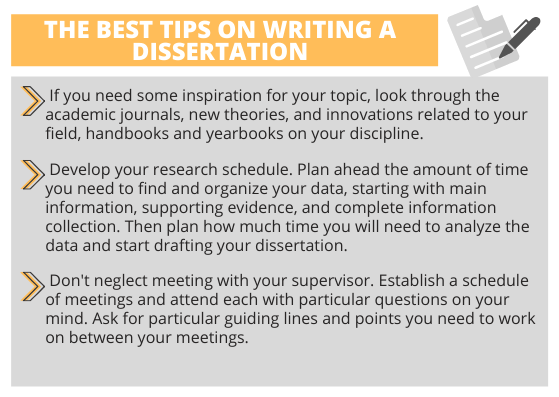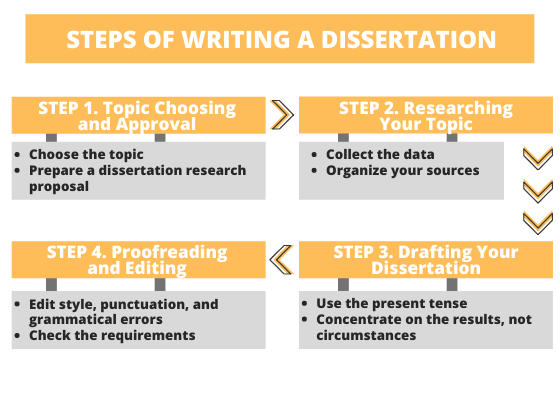How to Write a Dissertation
Writing Guide
A challenging project that shows your ability to conduct research and put your theoretical and practical knowledge to the study is called a dissertation. It is performed in order to make a contribution into the field and usually occurs during the doctoral study.
Its difficulty makes it understandable why so many people face problems with structuring and organizing their work. However, with the proper effort and some assistance, you can manage this challenging task.
The Purpose and Importance
Though different dissertations vary depending on the program, the primary purpose – to contribute to the field – stays the same. It is one of the largest and in-depth works that a student must perform in order to get a doctoral degree, as well as the hardest for many students. The main difficulty is, of course, to fight blocks and begin writing.

The Sectioning
The order of the chapters and their content may vary in accordance with the course, the program, and the topic. Some chapters may be added if the work is based on a few different case studies or themes. However, generally, the structure of such a work consists of 7 parts. Though one can be familiar with the concept of each of these elements as they are typical for other academic papers, it’s essential to understand their specifics as the parts of this work.
1. Abstract
A short annotation of the following work is called an abstract. It usually includes:
- The reason for writing a work and its importance
- The problem or the question that is the main object of the study
- The instruments, methods, and experiments used
- Results of the work
The main purposes of the abstract are to get a reader interested in the topic and the problem, explain their relevance, and give a brief summary of the following chapters.
The abstract is often the only part that is read, so its content should be as informative and understandable as possible.
2. Table of Contents
This is the list of all the chapters and their page numbers. It helps your reader navigate through the work. It is an essential part of any work of this type because of its length and structure.
3. Introduction
The beginning part of a paper can usually be compared to a funnel as it starts with generic sentences and then narrows down to more specific matters – your hypothesis.
This chapter helps to prepare your reader for the following content and provides all the necessary information on the topic’s background.
4. Instruments/Methodology
It explains how your work was implemented and what instruments you were using. The main purpose of giving such an explanation is to provide the reader with an opportunity to replicate the experiment and receive the same results.
5. Sources/Literature review
This part of the work aims to showcase the existing work performed in the field of your research. It helps define the importance of your contribution to the field and its connection to other studies.
6. The Body Chapters
The length and the total number of the chapters in the main body of your work may vary depending on the topic or discipline, but it can be roughly divided into two parts: Outcomes and Discussion. This is the most informative part of your work, as it presents the outcomes and your interpretation. It also uses the facts, evidence, and analysis to support your hypothesis.
Some dissertations (e.g., in the social studies) might be built around a few different case studies or experiments and their comparison, which often leads to dividing the main body into multiple chapters.
The route that you choose will also affect the design of the main body of – empirical and non-empirical methods imply completely different approaches.
7. Conclusion
In this part, you need to summarize and conclude your work. It describes what you have found through your work, your interpretation, suggestions for further exploring, and what value your work provides.
8. Bibliography/List of References
This part includes full details on each source that you are using through your work. It’s essential to be specific about the page numbers where a reader can find the exact quote, data, experiment results, facts, and statistics that you are mentioning in the text.
There are two major formatting styles: APA and MLA. Each of them has specifics and rules regarding various elements of academic papers, including the bibliography.
Steps of Writing
Hands down, a dissertation is a massive and time-consuming work. However, one can manage even such an intimidating task if one breaks it into smaller parts for a step-by-step process. Here are the steps of the working process.
Step 1. Start with the Topic and its Approval
You might already have some thoughts about what you want your work to be about. This is the time to narrow down the list of possible topics and make the final decision. There is no formula for making such a choice as it all depends on your fields of interest and your discipline.
Some tips on how and where to find a topic for your work:
- If you need some inspiration, look through the academic journals, various hypotheses, and innovations related to your field, handbooks, and yearbooks.
- Choose a topic that is not too broad or too narrow. It shouldn’t take years to look through all the relevant materials but also shouldn’t lack the sources to rely on.
- Ask your advisor or counselor for advice – they will tell you if the topic is appropriate to pick for your work.
Be sure to finish working on your preliminary research at this step and prepare some basic information and facts.
Proposal
Now, prepare and submit your research proposal that is something of a shorter version of a full work (usually around 10-15 pages long). It also has the following parts:
- Introduction
- Objectives and goals
- Methodology
- Literature review
- Constraints
The proposal provides an explanation of what you are going to do, what your goals are, and why your work is notable.
After submitting your study proposal, you will need it to be approved and signed by every member of the committee. Look up if there are any other strict requirements – talk to your committee chair or academic advisor.
Step 2. Explore Your Topic
This step is the most challenging, which takes a lot of time and effort. It will define the overall look of your project and the final outcomes. You might have already found something on your topic; now you need to find more credible resources, structure them, and organize your data.
Evidence Gathering
Usually, data collection for such work takes up to three months. Of course, it all depends on your field and your sources (particularly their accessibility). When collecting your data, you can turn to librarians for help, as well as attend seminars and workshops related to your research question. Don’t be shy to ask for advice from specialists in your field.
Reliable sources to get your data from:
- Surveys, interviews, experiments
- Case studies, archives, historical documents
- Reports, journals, books
Extra tip: Develop your schedule. Plan ahead the amount of time you need to find and organize your data, starting with the main one, supporting evidence, and complete data collection. Then plan how much time you will need to analyze the data and start drafting your piece.
A great way to find needed data is to look through the resources in Scholar , Core , Science.gov , Base , Ibiblio , etc. Remember that the Internet itself is hard to call reliable. Don’t use Wikipedia articles to get your data – use the sources from the bibliography section on the proper Wikipedia page.
Be sure to always double-check facts and statistical data from various sources to ensure you use the most accurate numbers and the latest data.

Putting Together
While researching, it’s easy to mess up when being overwhelmed. However, structuring and organizing your data are the best ways to keep a high productivity level.
When making notes and drafts for your future piece, you might find online tools such as Evernote very helpful as they allow you to leave comments, cite sources, and organize your notes in the most convenient way.
You can start writing right away – this is an effective tactic that helps fighting procrastination. If you have at least some parts written, it’s easier to come back to work and continue writing.
Extra tip: Don’t miss the chance to meet with your advisor. Establish a schedule of sessions and attend each with particular questions on your mind. Ask for particular guiding lines and points to manage between your meetings.
Step 3. Prepare the Draft
Here are a few general rules that you should keep in mind when working on the content of your dissertation:
- Use the present tense and active constructions.
- Define the terms that you use (by the reliable reference or detailed definition presented in the text).
- Don’t use jargon, slang, colloquialisms, contractions, etc.
- Support your statements by references or original work (survey data, interviews, experiments, etc.).
- Avoid using first and second person in a formal dissertation. For example, don’t write, “In this chapter, I will explain…” or “From this chapter, you will learn…” Use the following construction instead “This chapter explains…”
- Concentrate on the results, not the situations, circumstances, or facts involved.
- Avoid being judgmental and making biased conclusions.
Try to avoid sticking with particular paragraphs. In this case, it’s better to move further than trying to polish each chapter before starting another. When you get to the end of your work, you will be able to look at the beginning of it with fresh eyes.
Step 4. Proofread and Edit
When your draft is complete, it’s time to start polishing it. As a dissertation is a quite big work, it’s understandable that you might miss some typos and punctuation mistakes when looking it through for the first time. That’s why you will probably have to repeat this step a few times.
Use tools like Grammarly to check your text piece by piece and search for sentences that have unclear wording or the wrong word order. In the case of the dissertation, requesting professional editing from our team is a smart choice. It helps to polish the work without putting much effort and avoid making bad mistakes that can ruin even the greatest content. Our experts can also assist in writing your dissertation from the very beginning.
Don’t forget to edit the style errors, and make sure the logical flow of your text is alright. It’s as important as the content and grammar of your work as it directly affects the readability of your dissertation.
Now it’s time to talk to your advisor and discuss your work. You might get some tips on how to improve your work, so don’t miss this chance.
Writing a dissertation is a challenging task. However, we are sure that you can manage it. Good luck!

